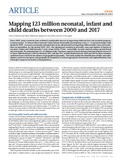| dc.identifier.citation | Burstein, R., Henry, N. J., Collison, M. L., Marczak, L. B., Sligar, A., Watson, S., Marquez, N., Abbasalizad-Farhangi, M., Abbasi, M., Abd-Allah, F., Abdoli, A., Abdollahi, M., Abdollahpour, I., Abdulkader, R. S., Abrigo, M., Acharya, D., Adebayo, O. M., Adekanmbi, V., Adham, D., Afshari, M., … Hay, S. I. (2019). Mapping 123 million neonatal, infant and child deaths between 2000 and 2017. Nature, 574(7778), 353–358. https://doi.org/10.1038/s41586-019-1545-0 | en_US |
| dc.description.abstract | Since 2000, many countries have achieved considerable success in improving child survival, but localized progress remains unclear. To inform efforts towards United Nations Sustainable Development Goal 3.2-to end preventable child deaths by 2030-we need consistently estimated data at the subnational level regarding child mortality rates and trends. Here we quantified, for the period 2000-2017, the subnational variation in mortality rates and number of deaths of neonates, infants and children under 5 years of age within 99 low- and middle-income countries using a geostatistical survival model. We estimated that 32% of children under 5 in these countries lived in districts that had attained rates of 25 or fewer child deaths per 1,000 live births by 2017, and that 58% of child deaths between 2000 and 2017 in these countries could have been averted in the absence of geographical inequality. This study enables the identification of high-mortality clusters, patterns of progress and geographical inequalities to inform appropriate investments and implementations that will help to improve the health of all populations. | en_US |

